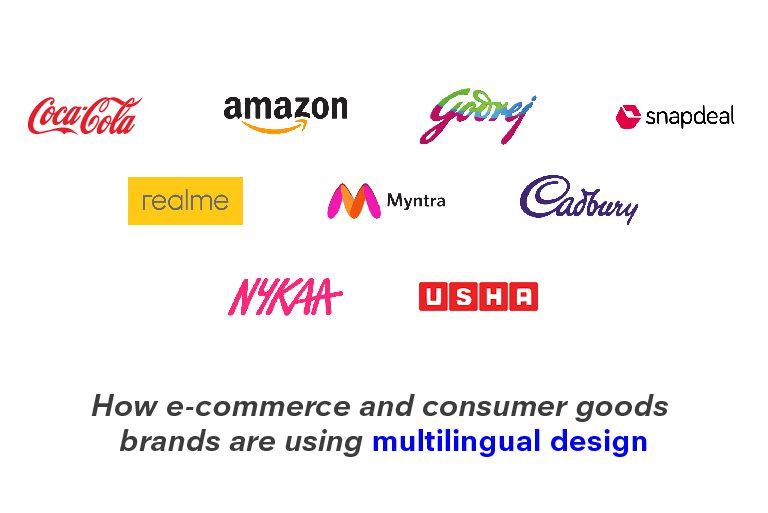Our glocal world has brought people and business closer than ever and offered brands opportunities to expand into new markets internationally. This wider audience and expansion comes with its own challenges, especially and particularly when you think of design – product, visual communication or graphic – brands need to consider the multilingual and culturally different societies.
Designers and brands understand that this requires them to have a cultural context and a deep comprehension of the linguistic diversity of the markets they are working to target. They have become mindful of the vital role a language, culture or a geography can have on their design approach. Let’s understand how a few leading brands in consumers goods and e-commerce use multilingual design strategy to target their audiences:
Also read: How design systems support efficiency for brands
For global consumer goods brands like: Coca Cola and Pepsi
These two global brands are global icons selling over hundreds of countries, catering to a diverse and very varied range of linguistic and cultural background consumers. Wonder how it works for Coca Cola and Pepsi in the many states of culturally diverse India to the culturally vivacious land of Mexico? It’s their creative use of multilingual and hyper localized design strategy. The brands focus on three main aspects amongst others:
A. Brand Identity:
One core focus for Coca-Cola and Pepsi is how they designed their multilingual logo. In a country like India, the hyper localization in their logo design came in languages like Hindi, Marathi, Telugu, Punjabi amongst others.
B. Packaging design:
to cater to the diverse linguistic and cultural background, they translate the brand’s product names into the local languages to make it easy for people to recognize and purchase their products.
C. Website localizations:
Vernacular content is liquid gold these days. These two consumer goods brands have localized their websites in many different languages to cater for its global audience and provide content more relevant to the people. Like in Japan they feature information more relevant to Japanese culture and traditions.
Also read: Role of a design manager in creating successful products and services
D. Ad campaigns and social media:
Targeted ads and social media platforms – all need hyper localization too. Mexico is all about football and India is all about cricket – both these consumers brands make sure their design strategy can be built around the local popular culture to target their audiences.
For e-commerce platforms like: Amazon, Myntra, Snapdeal
These e-commerce platforms work with a hyper-localized design strategy which enables them to cater to the unique needs and preferences of customers in different regions and markets. Offering their communication via design or otherwise to the audience in their own languages offers Amazon, Myntra, and Snapdeal the opportunity to provide a more personalized and relevant experience for customers which leads to loyalty and customer satisfaction.
A. Vernacular content on websites:
Operating in multiple countries is one thing, but for Amazon, Myntra and Snapdeal, India itself is a diverse market where they need to offer their website content in Hindi, Punjabi, Telegu, Marathi and other local Indian languages. All with wide range of audience that is their prime target market too. This is where all of them have successfully build vernacular content on their websites.
Also read: The growing opportunities in motion design
B. Product and packaging design:
All three brands work on their packaging and product design to match with their localized web content as well. How the product is showcased on the web, the UX of the design to the overall customer experience of it while unpacking, all small design elements are redefined keeping in mind the local language difference.
C. Ad campaign and social media content:
These brands make use of multilingual ad campaigns to connect to their users in the wide country of India. For example, Myntra is known to feature ads in local languages using local celebrities and influencers. The visual design is further backed with ad campaigns making sure the type is easy to comprehend and placed in an apt manner.
Also read: What is white space in design and why is it important
Here are some aspects designers should consider when designing for hyper localized and multilingual societies:
- Researching and understanding the local culture
For example, the colour red is a symbol of good luck in China, in India red is considered auspicious and worn often by the Indian brides on their wedding day while in African culture, red is associated with mourning and funerals. - Creating multilingual design variations
For example – in Hindi and English – we write and read from left to right while in Arabic the text is written and read from right to left. This reflects how the design for the same visual communication will need to be able to adapt to both writing styles and keep the message intact. - Adding local elements
A fine example of this is how Coca-Cola as a global brand changes the language of its logo from state to state in India and country to country globally – yet ensuring their brand identity is intact. They can build a connection with their Telugu audience in Southern India to the wide African continent. - Using new and emerging technologies
- Design for inclusivity
- Test the design for local markets.
These simple nuances are essential to learn when creating new designs that resonate with the local audience. Designing in the world of hyper-localization and multilingual societies requires a different approach to meet the needs of diverse markets. To succeed in these markets, designers must understand the local culture and language, create multilingual designs, incorporate local elements into the design, and test the design in local markets. By following these essential considerations, like Coca-Cola to Amazon – two global brands have done, they show that businesses can create designs that resonate with local audiences and achieve success in global markets.
Also read: The future of mobile design led by emotional intelligence



Want to Become a Designer ?
Strate is a unique design school that nurtures your talents as a designer by offering state-of-the art designing courses in Bangalore.
Join Strate